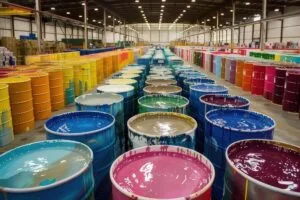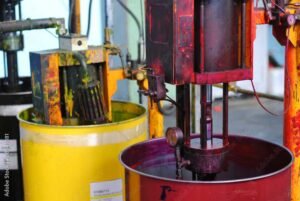Introduction to Solvent-Based Paint Manufacturing
Solvent-based paints are a category of coatings that utilize organic solvents as a primary component to dissolve the paint’s binding agents and pigments. Unlike water-based paints, which rely on water as their solvent, solvent-based paints typically consist of various chemicals including hydrocarbons, alcohols, and other organic compounds. These solvents play a crucial role in the formulation of the paint, impacting not only its viscosity and application properties but also the overall durability and finish of the applied layer.
There are several types of solvent-based paints, including alkyds, polyurethanes, and epoxy paints. Alkyd paints, for instance, are prized for their excellent adhesion and gloss retention, making them ideal for both interior and exterior applications. Polyurethane paints offer exceptional durability and resistance to scratches and weathering, often used in high-traffic areas or on surfaces that endure significant wear. Epoxy paints provide even greater resilience, frequently employed in industrial settings where chemical exposure may occur.
The typical applications of solvent-based paints include automotive coatings, industrial equipment finishes, and architectural uses where a tough and long-lasting finish is required. Their rapid drying times and hard finishes make them a popular choice among professionals and DIY enthusiasts alike. However, it is crucial to understand the implications of using these products, as the organic solvents can emit volatile organic compounds (VOCs), which may pose health risks if proper precautions are not followed.
Therefore, grasping the intricacies of solvent-based paint manufacturing is essential for both industrial applications and DIY projects. Knowledge of their composition, types, and applications helps users make informed choices and ensures effective usage, while also adhering to safety standards and environmental regulations.

Key Ingredients in Solvent-Based Paints
Solvent-based paints are complex formulations that consist of various key ingredients, each contributing to the final product’s performance, appearance, and drying characteristics. The primary components of solvent-based paints include pigments, binders, solvents, and additives. Understanding the purpose of these ingredients and their interactions is essential for comprehending how solvent-based paints function.
Firstly, pigments are crucial because they impart color and opacity to the paint. They can be organic or inorganic in nature, each providing distinct aesthetic qualities and durability. The choice of pigments affects not only the color but also the lightfastness and stability of the paint under different environmental conditions.
Binders, also known as resins, play a fundamental role in film formation. They are responsible for holding the pigment particles together and ensuring adhesion to the substrate. Various types of binders are utilized, such as alkyds, acrylics, and epoxies, each offering unique properties ranging from flexibility to hardness, thereby impacting the overall performance of the paint.
Solvents serve as the medium in which the other ingredients are dissolved or suspended. They are essential for adjusting the viscosity of the paint to ensure easy application and effective flow. Common solvents include aromatic hydrocarbons, aliphatic hydrocarbons, and esters, which possess varying degrees of volatility and evaporation rates. The choice of solvent significantly influences the drying time and the application characteristics of the paint, hence its importance in formulation.
In addition to pigments, binders, and solvents, various additives are incorporated into solvent-based paints to enhance specific properties. These can include anti-foaming agents, flow enhancers, and stabilizers, which improve the paint’s performance and application attributes. Each additive fulfills a precise role, ensuring the paint meets the required standards and expectations of users.
The Manufacturing Process of Solvent-Based Paints
The production of solvent-based paints involves a systematic and careful approach to ensure high-quality outcomes. The initial step is raw material selection, where various components such as pigments, resins, solvents, and additives are procured. Each of these raw materials serves a distinct purpose; pigments provide color, resins enhance adhesion and durability, while solvents facilitate the application process by reducing viscosity.
Upon gathering the necessary materials, the next phase is mixing. This entails combining the selected ingredients in specific proportions, ensuring uniform distribution of pigments throughout the mixture. This stage is critical, as any imbalance can lead to variations in color or texture in the final product.
Following mixing, the batch undergoes milling, a process that involves grinding the mixture to achieve a finer dispersion of pigments. This step is vital for the paint’s performance, as it directly affects the paint’s opacity and finish. The milling process often employs specialized equipment, such as bead mills, to achieve the desired particle size while retaining the properties of the paint.
The next step involves dispersion, where the pigments are thoroughly distributed within the resin matrix. This stage is crucial for ensuring that the paint maintains its color consistency and application properties. Quality control measures are integral throughout the entire manufacturing process, facilitating periodic testing to analyze the paint’s viscosity, drying time, and color accuracy.
Moreover, variations in the manufacturing process may occur depending on the type of solvent-based paint being produced. For instance, industrial paints may require more robust formulations compared to decorative paints. Rigorous adherence to manufacturing protocols not only ensures product reliability but also enhances customer satisfaction with the end-use performance of the paints produced.

Safety and Environmental Considerations
Paint manufacturing, particularly with solvent-based variants, carries inherent risks that necessitate stringent safety and environmental considerations. One primary concern is flammability, as many solvent-based paints contain volatile organic compounds (VOCs). These compounds can easily ignite and contribute to fires if proper precautions are not taken. Consequently, facilities involved in the production of such paints need to implement comprehensive fire safety protocols and ensure that storage areas are designed to minimize ignition risks.
Toxicity is another critical factor in the manufacturing process. Solvent-based paints may release harmful fumes that pose health risks to workers and, if not properly handled, can have detrimental effects on the environment. Therefore, it is essential for companies to provide adequate personal protective equipment (PPE) to employees, such as respirators, gloves, and goggles. Additionally, establishing proper ventilation systems throughout the facility can help mitigate exposure to harmful vapors, ensuring a safer working environment.
Environmental concerns associated with the production and disposal of solvent-based paints must also be addressed. VOCs not only affect indoor air quality but can contribute to air pollution when released into the atmosphere. As such, manufacturers must adhere to local and federal regulations concerning emissions and waste disposal. Implementing best practices for the safe storage of solvents—such as utilizing designated areas with appropriate containment measures—can significantly reduce environmental risks. Furthermore, educating workers on the correct disposal methods for unused paints and solvents is crucial for minimizing ecological impact.
By focusing on safety and adhering to regulatory standards, companies can streamline the paint manufacturing process and promote a healthier work environment, thereby contributing positively to public health and environmental sustainability.
Quality Control in Paint Production
Quality control is an integral aspect of the manufacturing process of solvent-based paints, as it ensures that the final products meet specified standards of performance, consistency, and safety. The focus on quality control begins with the selection of raw materials, which must be carefully evaluated to guarantee compatibility and compliance with regulatory requirements. Each ingredient used in the formulation of solvent-based paints plays a crucial role in the overall quality and effectiveness of the finished product.
One of the primary methods of quality control in paint production is viscosity testing. Viscosity, which measures a fluid’s resistance to flow, is a critical property that influences the application and performance of paints. By employing viscometers, manufacturers can gauge the flow characteristics of the paint to ensure it adheres to the desired specifications. Consistent viscosity levels help maintain optimal application properties, thus contributing to better film formation and finish quality.
Color matching also plays a significant role in quality control, particularly for solvent-based paints used in decorative applications. Manufacturers typically rely on color matching instruments and visual assessments to ensure that the final paint product meets the established color standards. This process may involve multiple iterations, as even slight deviations can impact customer satisfaction and project outcomes.
Adherence tests are another essential quality control measure in paint production. These tests assess how well the paint bonds to various surfaces, which is crucial for durability and resistance to peeling or flaking. By conducting adhesion tests under different environmental conditions, manufacturers can evaluate the performance of their products in real-world scenarios.
In summary, quality control is paramount in the production of solvent-based paints, encompassing various testing methods such as viscosity tests, color matching, and adherence assessments. These practices ensure that the end products not only meet consumer expectations but also provide reliable performance over time.

Innovations in Solvent-Based Paints
The landscape of solvent-based paint manufacturing is undergoing significant transformation, driven by advancements ranging from formulation innovations to regulatory changes. One of the most noteworthy trends in recent times has been the development of low-VOC (volatile organic compounds) and eco-friendly formulations. These innovations are essential for meeting stricter environmental regulations, as they mitigate the adverse effects of traditional solvent-based paints on both human health and the environment. Manufacturers are focusing on creating high-performance paints that are not only effective but also sustainable.
In addition to low-VOC formulations, the industry has been witnessing a surge in the use of bio-based solvents derived from renewable resources. These bio-solvents provide a more sustainable alternative to petroleum-derived solvents and offer similar performance characteristics. The shift toward these innovations reflects a growing awareness among consumers and manufacturers alike regarding the importance of eco-conscious practices in the paint industry.
Another significant trend is the integration of advanced technologies in the manufacturing processes. For instance, the use of nanotechnology in the formulation of solvent-based paints enhances properties such as durability, scratch resistance, and gloss retention. This advancement not only improves the aesthetic qualities of the paint but also extends the lifespan of the coatings, thus adding value to the end product.
Furthermore, manufacturers are increasingly adopting smart manufacturing practices, leveraging data analytics and automation to refine production techniques. This fosters greater efficiency, reduced waste, and a more streamlined approach to paint production. Additionally, these innovations are supported by ongoing research and development efforts aimed at exploring new materials and technologies that can further improve the performance and environmental footprint of solvent-based paints.
Overall, the advancements in solvent-based paint technology, particularly in low-VOC and environmentally friendly formulations, present exciting opportunities for the industry. As regulations tighten and consumer expectations evolve, the embrace of innovation will play a pivotal role in shaping the future of solvent-based paint manufacturing.
Applications of Solvent-Based Paints
Solvent-based paints are widely utilized across various industries, each requiring advanced and durable solutions for a myriad of applications. In the automotive sector, solvent-based formulations are favored due to their exceptional adhesion properties and resistance to environmental elements. These paints offer enhanced durability and a high-gloss finish, making them ideal for protecting vehicles against wear and tear while maintaining aesthetic appeal. Their quick-drying characteristics enable efficient production processes, allowing manufacturers to expedite assembly lines without sacrificing quality.
In the construction industry, solvent-based paints are commonly used for both interior and exterior surfaces. The ability of these paints to withstand fluctuating weather conditions, such as moisture and UV exposure, makes them suitable for protective coatings on buildings and structural components. Moreover, solvent-based formulations often provide a smoother application and superior coverage, reducing the number of coats needed and thus minimizing labor costs. This is particularly advantageous in commercial projects where time and efficiency are critical.
Home décor is another domain where solvent-based paints have gained popularity. Consumers often choose these paints for wooden surfaces, furniture, and trim due to their ability to provide a durable, hard finish that enhances the natural beauty of the materials. Additionally, the range of colors and finishes available in solvent-based paints gives homeowners the flexibility to achieve their desired aesthetic. The longevity of these paints also means that home projects maintain their allure, requiring less frequent repaints compared to water-based alternatives.
Overall, the numerous applications of solvent-based paints in diverse industries underscore their importance in modern manufacturing and home improvement. By integrating advanced technology, these paints demonstrate versatility and effectiveness, making them a preferred choice for various projects.
Challenges in Solvent-Based Paint Manufacturing
The production of solvent-based paints encounters a myriad of challenges, primarily driven by regulatory pressures and the growing demand for environmentally sustainable products. A significant concern involves compliance with strict regulations aimed at reducing volatile organic compounds (VOCs) emissions, which can pose health risks and contribute to air pollution. Manufacturers are pressured to reformulate their products to meet these standards while maintaining performance and quality, creating a complex balancing act between compliance and functionality.
Another crucial challenge pertains to the increasing competition posed by water-based paints. These alternatives have gained popularity due to their lower environmental impact and reduced health risks. As consumer preferences shift towards greener products, solvent-based paint manufacturers must innovate and adapt their formulations to compete effectively in the marketplace. This not only includes reformulating existing products but also investing in research and development to create new, high-performance paint options that meet consumer expectations.
In addition to regulatory and competitive pressures, the rising costs of raw materials and production processes remain persistent challenges. Solvent-based paints typically rely on petroleum-derived solvents, whose prices can be volatile due to market fluctuations. Manufacturers must explore cost-effective sourcing and production strategies to mitigate these impacts while ensuring their end products remain attractive in terms of pricing and quality.
To navigate these challenges, solvent-based paint manufacturers can adopt various strategies. Emphasizing sustainability in the product development process can help bridge the gap between regulatory compliance and market demand. Implementing advanced technologies for low-VOC formulations, alongside effective marketing strategies that highlight the benefits of solvent-based paints, will be crucial. Moreover, fostering collaborations with chemical suppliers and researchers may lead to innovative solutions that enhance sustainability without sacrificing performance.
Conclusion and Future Outlook
In revisiting the key points discussed throughout this blog post, it is evident that solvent-based paint manufacturing stands at a crossroads, influenced by evolving consumer preferences, stringent regulations, and the industry’s shift towards sustainability. The versatility and robustness of solvent-based paints have made them a staple in various applications, ranging from automotive finishes to industrial coatings. However, growing environmental concerns and health implications associated with volatile organic compounds (VOCs) are prompting manufacturers to reconsider their formulations and practices.
The trends indicate a growing consumer preference for low-VOC and eco-friendly alternatives. As awareness surrounding environmental sustainability increases, manufacturers are compelled to innovate. Advances in technology are paving the way for developing solvent-based formulations that minimize harmful emissions while maintaining performance. Innovations in bio-based solvents and the incorporation of greener additives highlight the industry’s commitment to responsible manufacturing practices. Furthermore, manufacturers are now more focused on educating consumers regarding the safety and sustainability of their products, which could influence buying decisions in the near future.
Regulatory pressures continue to shape the landscape of solvent-based paint manufacturing. Governments around the world are implementing stricter regulations to limit VOC emissions. Compliance with these regulations will be crucial for companies to operate sustainably and remain competitive in the market. There is also an increasing push for more transparent labeling practices, allowing consumers to make informed choices about the products they use in their homes and businesses.
In conclusion, the future of solvent-based paint manufacturing seems poised for significant change. The industry must adapt to meet consumer demands and regulatory requirements while committing to sustainable practices. By balancing innovation with environmental responsibility, manufacturers can secure a promising future for solvent-based paints in a competitive and conscientious marketplace.


